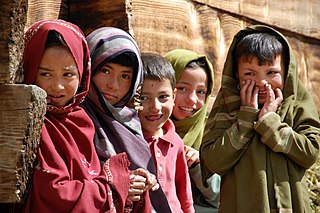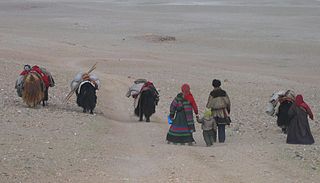Related Research Articles

The Tibetic languages form a well-defined group of languages descended from Old Tibetan. According to Tournadre (2014), there are 50 languages, which split into over 200 dialects or could be grouped into 8 dialect continua. These languages are spoken in the Tibetan Plateau and in the Himalayas in Gilgit-Baltistan, Aksai Chin, Ladakh, Nepal, Himachal Pradesh, Uttarakhand, and Bhutan. Classical Tibetan is the major literary language, particularly for its use in Buddhist literature.

Pakistan is a multilingual country with dozens of languages spoken as first languages. The majority of Pakistan's languages belong to the Indo-Iranian group of the Indo-European language family.

Ladakh is a region administered by India as a union territory and constitutes an eastern portion of the larger Kashmir region that has been the subject of a dispute between India and Pakistan since 1947 and India and China since 1959. Ladakh is bordered by the Tibet Autonomous Region to the east, the Indian state of Himachal Pradesh to the south, both the Indian-administered union territory of Jammu and Kashmir and the Pakistan-administered Gilgit-Baltistan to the west, and the southwest corner of Xinjiang across the Karakoram Pass in the far north. It extends from the Siachen Glacier in the Karakoram range to the north to the main Great Himalayas to the south. The eastern end, consisting of the uninhabited Aksai Chin plains, is claimed by the Indian Government as part of Ladakh, and has been under Chinese control since 1962.

Balti is a Tibetic language natively spoken by the ethnic Balti people in the Baltistan region of Gilgit−Baltistan, Pakistan, Nubra Valley of the Leh district and in the Kargil district of Ladakh, India. The language differs from Standard Tibetan; many sounds of Old Tibetan that were lost in Standard Tibetan are retained in the Balti language. It also has a simple pitch accent system only in multi-syllabic words while Standard Tibetan has a complex and distinct pitch system that includes tone contour.

The Ladakhi language is a Tibetic language spoken in the disputed Indian union territory of Ladakh. It is the predominant language in the Buddhist-dominated district of Leh. Though a member of the Tibetic family, Ladakhi is not mutually intelligible with Standard Tibetan. Ladakhis and Tibetans usually communicate with each other in Hindi or English as they do not understand each other’s languages clearly.

The Baltis are an ethnic group of Tibetan descent who are native to the Pakistani-administered territory of Gilgit−Baltistan and the Indian-administered territory of Ladakh, predominantly in the Kargil district with smaller concentrations present in the Leh district. Outside of the Kashmir region, Baltis are scattered throughout Pakistan, with the majority of the diaspora inhabiting prominent urban centres such as Lahore, Karachi, Islamabad and Rawalpindi.

Purgi, Burig, Purki, Purik, Purigi or Puriki is a Tibetic language closely related to the Balti language. Purgi is natively spoken by the Purigpa people in Ladakh region of India and Baltistan region of Pakistan.

The Changtang is a part of the high altitude Tibetan Plateau in western and northern Tibet extending into the southern edges of Xinjiang as well as southeastern Ladakh, India, with vast highlands and giant lakes. From eastern Ladakh, the Changtang stretches approximately 1,600 kilometres (990 mi) east into Tibet as far as modern Qinghai. The Changtang is home to the Changpa, a nomadic Tibetan people. The two largest settlements within the Tibetan Changtang are Rutog Town the seat of Rutog County and Domar Township the seat of Shuanghu County.

Zorawar Singh was a military general of the Dogra Rajput ruler, Gulab Singh of Jammu. He served as the governor (wazir-e-wazarat) of Kishtwar and extended the territories of the kingdom by conquering Ladakh and Baltistan. He also boldly attempted the conquest of Western Tibet but was killed in battle of To-yo during the Dogra-Tibetan war. In reference to his legacy of conquests in the Himalaya Mountains including Ladakh, Tibet, Baltistan and Skardu as General and Wazir, Zorowar Singh has been referred to as the "Napoleon of India", and "Conqueror of Ladakh".
Rupshu is a high elevation plateau and valley and an eponymous community development block in southeast Ladakh.

The Brokpa, sometimes referred to as Minaro, are a small ethnic group mostly found in the union territory of Ladakh, India around the villages of Dha and Hanu. Some of the community are also located across the Line of Control in Baltistan in the villages around Ganokh. They speak an Indo-Aryan language called Brokskat. The Brokpa are mostly Vajrayana Buddhist while some are Muslim.
Brokskat or Minaro is an endangered Indo-Aryan language spoken by the Brokpa people in the lower Indus Valley of Ladakh and its surrounding areas. It is the oldest surviving member of the ancient Dardic language. It is considered a divergent variety of Shina, but it is not mutually intelligible with the other dialects of Shina. It is only spoken by 2858 people in Ladakh and 400 people in the adjoining Baltistan, part of Pakistan-administered Kashmir.

Korzok, དཀོར་མཛོད་ is a Tibetan Buddhist monastery belonging to the Drukpa Lineage. It is located in the Korzok village, on the northwestern bank of Tso Moriri (lake) in Leh District, Ladakh, India. The gompa (monastery), at 4,560 metres (14,960 ft), houses a Shakyamuni Buddha and other statues. It is home to about 70 monks. It is 211 km southeast of Leh, 164 km southeast of Upshi, east of Meroo and 58 km south of Mahe.
The Changthang Wildlife Sanctuary is a high altitude wildlife sanctuary located in the Ladakhi adjunct of the Changthang plateau in the Leh District of the union territory of Ladakh. It is important as one of the few places in India with a population of the Kiang or Tibetan Wild Ass, as well as the rare Black-necked Crane. Changthang Wildlife Sanctuary covers an area of 4000 km2.
The first portion of the Bible, the Gospel of John, in a Tibetic language was translated by Moravian Church missionaries William Heyde, Edward Pagel, and Heinrich August Jäschke, and later Dr. August Francke. It was printed in 1862 at Kyelang capital of Lahul in Kashmir. The whole New Testament was printed in 1885 in Ladakh. Another version was translated in 1903. So as not to have the problem of various dialectal differences it was translated into classical Tibetan, but this was not understood by most people. Yoseb Gergen, a Tibetan Christian translated the entire Bible, complete in 1935. This version was translated into a dialect of Tibetan Gergen had accidentally stumbled across, and which was understandable by all Tibetans. It was finally published in 1948. This is known in India as the Tibetan OV Bible. Eliya Tsetan Phuntshog published a New Testament in 1970. There is currently a project going on to translate the Bible into the East Tibetan dialect.

Chumathang is a village in Leh District, Ladakh in northern India on the banks of the Indus river. Chumathang village is among the first villages in the Changthang region to have its own power station and government high school which was only possible under the guidance of Mr Gonbo. Famous for its hot spring which attracts many tourists all over the world, even the local people come every year to take the medicinal benefits from the hot spring. There is an old monastery or gonpa which is located near the road which is about more than 400 years old and is among the oldest monasteries of Ladakh.
The Ladakhi–Balti languages or Western Archaic Tibetan languages are a subgroup of the Tibetic languages spoken in the Ladakh region of India and in the Gilgit-Baltistan territory of Pakistan. The lects lack mutual intelligibility and are considered separate languages by their speakers. The grouping includes:

Ladakhis or Ladakhi people or Ladakspa are an ethnic group and first-language speakers of the Ladakhi language living in the Ladakh region in the northernmost part of Jammu Kashmir and Tibet in China. A small number of Ladakhis are also found in Baltistan, Pakistan.

The culture of Ladakh refers to the traditional customs, belief systems, and political systems that are followed by Ladakhi people in India. The languages, religions, dance, music, architecture, food, and customs of the Ladakh region are similar to neighboring Tibet. Ladakhi is the traditional language of Ladakh. The popular dances in Ladakh include the khatok chenmo, cham, etc. The people of Ladakh also celebrate several festivals throughout the year, some of the most famous are Hemis Tsechu and Losar.

The Shamskat dialect of the Ladakhi language is spoken in the Sham region of Ladakh, a region administered by India as a union territory. Along the Indus, there is a clear geographical boundary between two dialects of Shamskat and Kenskat. Nimo, the first village of Shamskat speakers, lies in the sharply cut basin near the narrow gorge of Indus river. It is the predominant language in the west of the Buddhist-dominated district of Leh. Shamskat pronunciation resembles that of Old Tibetan. Shamskat retains its Classical Tibetan vocabulary, while the Balti and Purgi have little influence from the vocabulary of its neighbour Shina. The native speakers of these languages are called Shamma.
